Featured Articles
The Beast of Stillman’s Gym, Part 3
The Beast of Stillman’s Gym
PART 3: THE BULL IN BOSTON GARDEN
Jake LaMotta stands in a lawyer’s office in New York City. He recently found out that he was tricked into a signing a contract that would give his manager a piece of him for eight years –-and he ain’t happy. He rips a release form from his pocket and slaps it on the desk in front of him. “Sign,” he says. The manager reads it and hands it to his lawyer. “Jake, I can’t sign that,” he squeaks. “You cheap, chiseling son of a b*tch,” LaMotta says, “You sign that right here and you sign it right now or I’ll strangle you. You think I’m kidding? Right here and right now, or you go out that door dead!”
The manager signed the release, then went to the cops. He said that the fighter assaulted him by kicking him in the stomach and threatening to hit him with a heavy book-end. It made the papers and didn’t do LaMotta’s public image any favors, not that he gave a damn. He beat the rap in criminal court but lost the civil suit and it ended up costing him four large to get rid of his first and last manager. After that, his brother handled his affairs on paper though LaMotta was really in charge. LaMotta was always in charge.
Fueled by the heartfelt belief that the whole world was rotten, LaMotta belonged on a shrink’s couch as much as he belonged in a boxing ring. He fought as if pain was pleasure, often not even bothering to get out of the way of punches despite the fact that his skills were better than anyone knew. It was as if he had something to prove; Or something to pay for. “Subconsciously,” he said when he was old, “I fought as if I didn’t deserve to live.”
Out of his pathology sprang a principle that benefitted not only fans but his own legacy; LaMotta feared no man. And without a mobbed-up manager to maneuver and protect him, he came up the hard way, with a reputation built on those high-risk, low-reward killers that gave champions the heebie-jeebies. Unlike other white prospects who were fed a steady diet of low-cal cream puffs, LaMotta was eye-to-eye with boxing’s roiling, broiling, black underclass. He knew them. “A colored fighter could starve in those days… a lot of them would have to fight with handcuffs on just to get a pay night here and there,” he said, “And some of them were great, believe me.” Great enough to chase “some high-priced top-notchers right out of the ring…
“When one of those bombers got a chance against a white kid on the square, they sure tried their best to show what they could do, because they all had a dream that maybe they’d get enough of an audience clamoring for them so that someday some promoter would give them the chance they deserved and they’d get a shot at the real money. And I mean they were hungry fighters. You would just about have to kill them before they’d give up. Well, I had something going for me too, on that score –-I was just as hungry as they were.”
LaMotta knew Murderers’ Row, and Murderers’ Row knew him.
The trajectory of his career mirrored Archie Moore’s. He was tested in the same fires as Archie Moore. Both became “policemen” in the middleweight division and faced those “colored bombers” before getting a title shot years after they earned it. They never forgot the names of those men. Even in this, the loneliest of sports, the fighter knows that he does not forge himself. He knows that triumphs are measured not by what so much as by who was overcome. In a manner of speaking, both LaMotta and Moore dedicated memorials to those who heaved them into starry greatness even as they themselves stayed behind.
LaMotta was Rocky Graziano’s policeman. “Rocky liked to use the tag with me because I was knocking off guys he would like to give a miss too,” he recalled, “There are always some kinds of fighters you’d just as soon not fight –-the wild swingers, the butters, the ones you just might lose to.” Graziano called him a policeman “long before he won the championship because he didn’t want to be eliminated before he won the title,” and LaMotta was good to clear the path.
Bert Lytell was on that path, and he wasn’t going anywhere.
On April 27th 1945, the bull snorted in his corner at Boston Garden. Bert, outweighed by 6¾ lbs, was across the ring, ripped and ready for his fourth bout that month. LaMotta had never faced a southpaw before, not that he gave a damn. He was confident that he had the answers. How to beat a southpaw? “Push him back,” he said forty years later when asked how fellow headcase Roberto Duran could defeat Marvin Hagler, “keep on top of him, don’t let him advance to you, that’s how…”
If LaMotta read recent press clippings, he would have expected this one to be aggressive and climb all over him. In February, Bert set a blistering pace against Coolidge Miller, twice ignoring the bell to end the round. Earlier in April, he “applied a sleep-producing wallop” to Irish Johnny Ryan with two seconds left in the third. Bert could sprout horns and charge in when the situation called for it, but he had more dimensions. He reminded doubting reporters that it was speed and skill that saw Robinson defeat LaMotta three out of four times. “I believe the same assets will make it possible for me to win the duke at the [Boston] Garden,” he said, “I am faster than LaMotta and when Jake comes rushing at me he will be an easy target.” He would not try to outbull this bull; instead he intended to wave a red rag just out of range to neutralize any ideas about taking away his southpaw advantage. Bert intended to confuse him.
It almost worked.
Halfway through the first round and frequently throughout the bout, a baffled LaMotta briefly turned southpaw himself in an effort to land something on the 4-1 underdog. He seemed unsure of what to do as Bert circled around him with constant right jabs and hard lefts. According to the Boston Globe, Bert was “an ambitious bicyclist”; though the Boston Evening American specified that he only backed away in the last round and spent the earlier rounds standing up and outboxing him. “Going into the eighth session,” it read the next morning, “Lytell had a commanding lead. His boxing skill and ability to score had LaMotta in serious trouble.” At one point, LaMotta stood center-ring with his hands dropped in frustration and waved him in. In the third, Bert fired over a left cross which opened a cut over his right eye; in the seventh, a left hook by LaMotta sent Bert’s mouthpiece flying.
At the end of ten rounds, LaMotta’s hand was raised in a split decision. The crowd booed loudly.
Sportswriter Jack Conway believed it would take “a return bout to determine whether LaMotta or Lytell is the better fighter,” though many of his peers argued that the better fighter had already been determined. W.A. Hamilton saw LaMotta take four rounds and those by close margins, while Bert took five rounds by country miles. Doc Almy, one of Boston’s most distinguished boxing experts, scored the fight seven rounds to three in Lytell’s favor for doing “far more than his opponent who landed more often in the air than against his rival.” Local boxing writer Eddie Welch had Bert up by eight rounds to two. “Jake LaMotta,” he quipped, “must have thought Sugar Ray Robinson was in the ring with him instead of Lytell.” Some surmised that a Massachusetts boxing rule placing undue emphasis on aggression, whether or not it is effective, worked in LaMotta’s favor.
All the same, Lytell’s “ring generalship, nimble footwork, and fine boxing” convinced Nat Fleischer that it was his best showing. The Ring took note.
It had been only twelve months since Calvin Coolidge Lytle was working as an attendant at a Brooklyn garage; only nine months since “The Chocolate Kid” lost his first professional bout. After earning the decision over LaMotta by fans and much of the boxing press if not the judges, Bert Lytell broke into the top ten of the middleweight division like a brick through a window.
____________________________
Sugar Ray, the Mob, and Bert Lytell, who finds himself chasing one and running from the other in PART 4 OF “THE BEAST OF STILLMAN’S GYM.” (Who needs Harry Potter when you can read stuff like this?)
Graphic is from Sport Magazine, 1949.
LaMotta’s issues with his manager recounted in Raging Bull by Jake LaMotta, pp. 87, 155 and “Lamotta Charged With Assaulting Manager,” Worcester Evening Gazette 11/17/44. LaMotta and Moore’s “memorials” are found in their autobiographies, and in Moore’s case, several newspaper articles from the 1950s. LaMotta-Lytell reported in Boston Evening American 4/27/45; LaMotta on how to beat a southpaw in “The Great Middleweights Talk About The Fight” by Peter Heller, Boxing Scene Collector’s Edition “Duran Vs. Hagler: The Fight of the Century.” Lytell’s fight with Ryan and comments about Robinson found in Boston Evening American, 4/13, 27/45; Lytell-Miller in Providence Journal 2/20/45; LaMotta-Lytell in Boston Evening American, Boston Globe, Boston Herald, AP, and Providence Journal 4/28/45; Nat Fleischer and Doc Almy’s comments in The Ring, July 1945.
Springs Toledo can be contacted at scalinatella@hotmail.com“>scalinatella@hotmail.com.
-
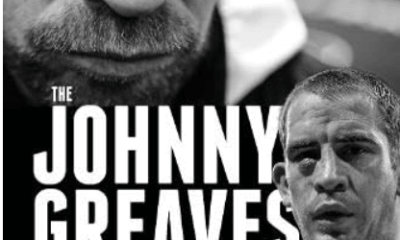
 Featured Articles3 weeks ago
Featured Articles3 weeks agoThomas Hauser’s Literary Notes: Johnny Greaves Tells a Sad Tale
-
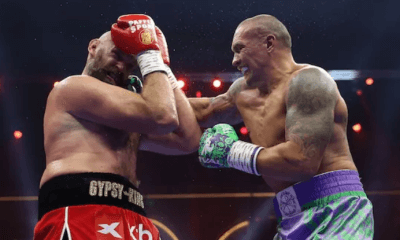
 Featured Articles2 weeks ago
Featured Articles2 weeks agoBoxing Notes and Nuggets from Thomas Hauser
-
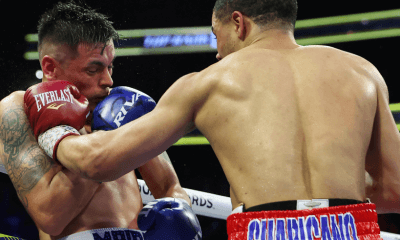
 Featured Articles4 weeks ago
Featured Articles4 weeks agoUndercard Results and Recaps from the Inoue-Cardenas Show in Las Vegas
-
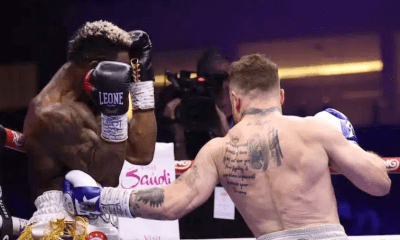
 Featured Articles4 weeks ago
Featured Articles4 weeks agoCanelo Alvarez Upends Dancing Machine William Scull in Saudi Arabia
-
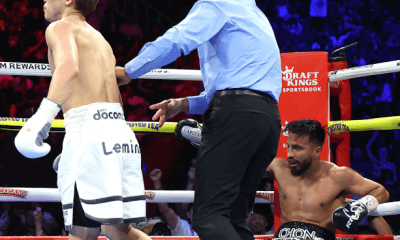
 Featured Articles4 weeks ago
Featured Articles4 weeks agoBombs Away in Las Vegas where Inoue and Espinoza Scored Smashing Triumphs
-
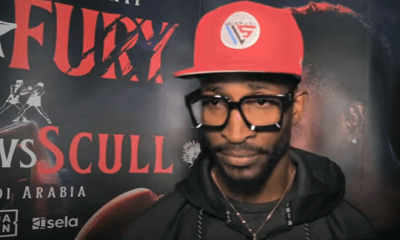
 Featured Articles4 weeks ago
Featured Articles4 weeks agoArne’s Almanac: The Good, the Bad, and the (Mostly) Ugly; a Weekend Boxing Recap and More
-
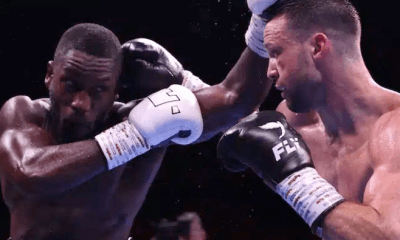
 Featured Articles1 week ago
Featured Articles1 week agoEkow Essuman Upsets Josh Taylor and Moses Itauma Blasts Out Mike Balogun in Glasgow
-
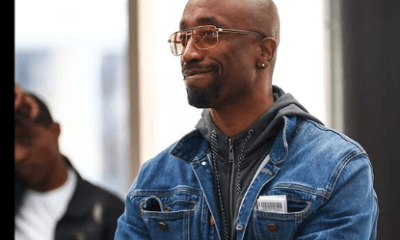
 Featured Articles4 weeks ago
Featured Articles4 weeks ago“Breadman” Edwards: An Unlikely Boxing Coach with a Panoramic View of the Sport




















1 Comment